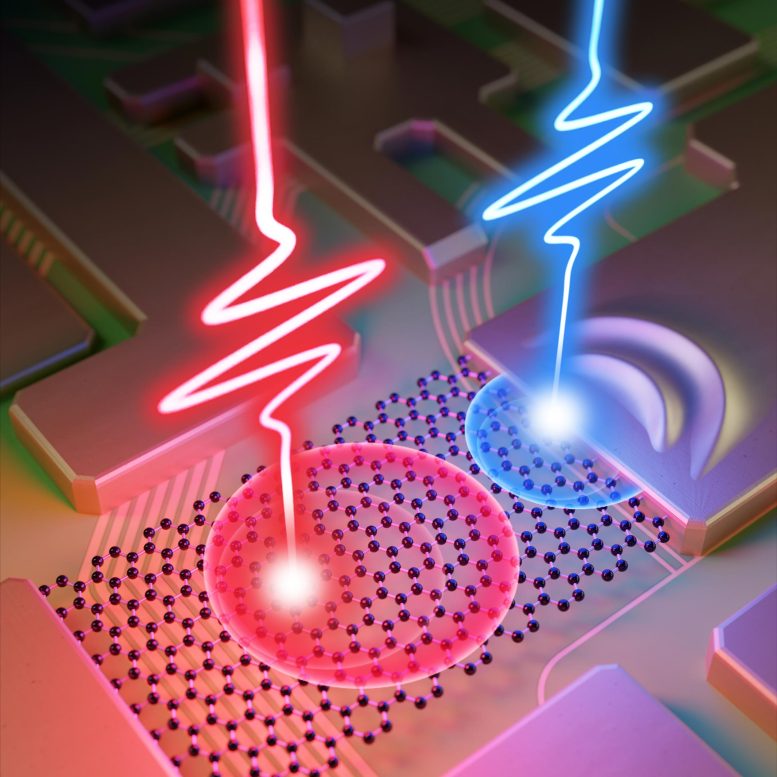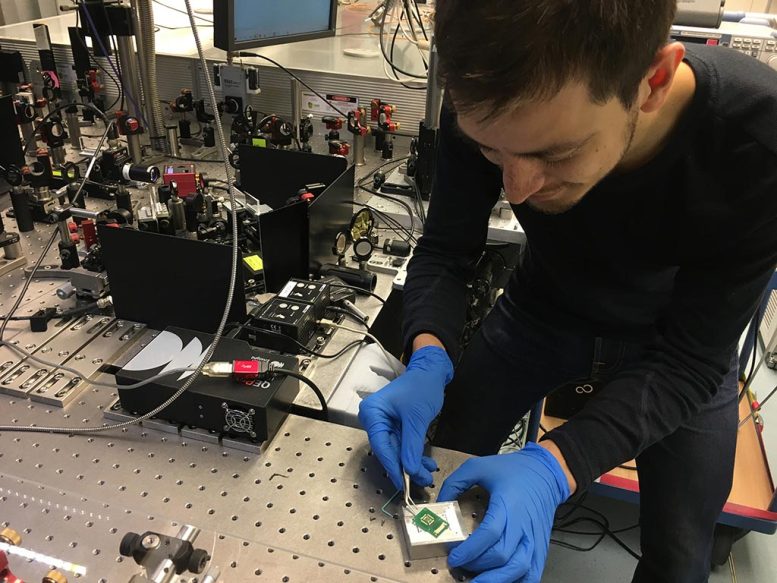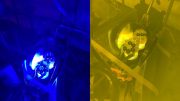
Illustration of the gold-graphene structure in which electron waves from real and virtual charges are targeted with two ultrafast laser pulses. The combined effect can be used in an ultrafast logic gate. Credit: Michael Osadciw, University of Rochester
Simulating complex scientific models on the computer or processing large volumes of data such as editing video material takes considerable computing power and time. Researchers from the Chair of Laser Physics at Friedrich-Alexander-Universität Erlangen-Nürnberg (FAU) and a team from the University of Rochester in New York have demonstrated how the speed of fundamental computing operations could be increased in the future to up to a million times faster using laser pulses. Their findings were published on May 11, 2022, in the journal Nature.
The computing speed of today’s computer and smartphone processors is given by field-effect transistors. In the competition to produce faster devices, the size of these transistors is constantly decreased to fit as many together as possible onto chips. Modern computers already operate at the breathtaking speed of several gigahertz, which translates to several billion computing operations per second. The latest transistors measure only 5 nanometers (0.000005 millimeters) in size, the equivalent of not much more than a few atoms. There are limits to how far chip manufacturers can go and at a certain point, it won’t be possible to make transistors any smaller.
Light is faster
Physicists are working hard to control electronics with light waves. The oscillation of a light wave takes approximately one femtosecond, which is one-millionth of one billionth of a second. Controlling electrical signals with light could make the computers of the future over a million times faster, which is the aim of petahertz signal processing or light wave electronics.
From light waves to current pulses
Electronics are designed to transfer and process signals and data in the form of logical information, using binary logic (1 and 0). These signals may also take the form of current pulses.
Researchers from the Chair of Laser Physics have been investigating how light waves can be converted to current pulses for several years. In their experiments, the researchers illuminate a structure of graphene and gold electrodes with ultrashort laser pulses. The laser pulses induce electron waves in the graphene, which move toward the gold electrodes where they are measured as current pulses and can be processed as information.
Real and virtual charges
Depending on where the laser pulse hits the surface, the electron waves spread differently. This creates two types of current pulses which are known as real and virtual charges.
“Imagine that graphene is a pool and the gold electrodes are an overflow basin. When the surface of the water is disturbed, some water will spill over from the pool. Real charges are like throwing a stone into the middle of the pool. The water will spill over as soon as the wave that has been created reaches the edge of pool, just like electrons excited by a laser pulse in the middle of the graphene,” explains Tobias Boolakee, lead author of the study and researcher at the Chair of Laser Physics.
“Virtual charges are like scooping the water from the edge of the pool without waiting for a wave to be formed. With electrons, this happens so quickly that it cannot be perceived, which is why it is known as a virtual charge. In this scenario, the laser pulse would be directed at the edge of the graphene right next to the gold electrodes.” Both virtual and real charges can be interpreted as binary logic (0 or 1).
Logic with lasers
The laser physicists at FAU have been able to demonstrate with their experiments for the first time that this method can be used to operate a logic gate – a key element in computer processors. The logic gate regulates how the incoming binary information (0 and 1) is processed. The gate requires two input signals, here electron waves from real and virtual charges, excited by two synchronized laser pulses. Depending on the direction and strength of the two waves, the resulting current pulse is either aggregated or erased. Once again, the electrical signal that the physicists measure can be interpreted as binary logic, 0 or 1.
“This is an excellent example of how basic research can lead to the development of new technology. Through fundamental theory and its connection with the experiments, we have uncovered the role of real and virtual charges which has opened the way to the creation of ultrafast logic gates,” says Ignacio Franco from the University of Rochester.
“It will probably take a very long time before this technology can be used on a computer chip. But at least we know that light wave electronics is a feasible technology,” adds Tobias Boolakee.
Reference: “Light-field control of real and virtual charge carriers” by Tobias Boolakee, Christian Heide, Antonio Garzón-Ramírez, Heiko B. Weber, Ignacio Franco and Peter Hommelhoff, 11 May 2022, Nature.
DOI: 10.1038/s41586-022-04565-9









Be the first to comment on "Laser Pulses for Ultrafast Signal Processing Could Make Computers a Million Times Faster"